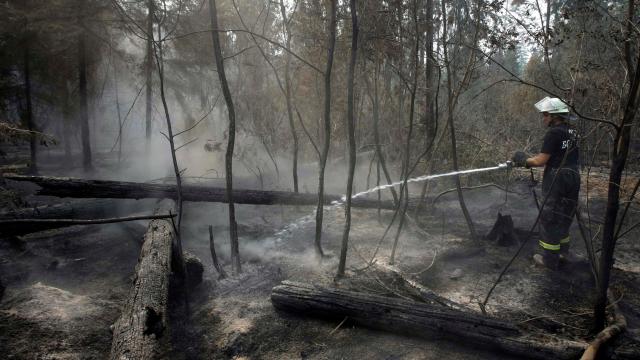The rise of zombie fires is the latest iteration of climate horrors. The world became acquainted with them last summer when fires in Siberia that had been smouldering underground all winter reignited in the summer. They pose a major problem in a warming world, but scientists have come up with a way to extinguish them that’s more effective than water, and they’ve outlined the findings in a recently released paper.
Zombie fires occur when summer blazes ignite in areas rich in flammable peat soil. As fall sets in, summer fires can continue to smolder in the peat later and even last through the winter under a thick layer of snow, reemerging once it melts. The pattern played out across Siberia last year amid a record fire season, but zombie fires have also been observed in Alaska as well as in hotter climates with peat-laden soil such as Southeast Asia.
In addition to being spooky, they’re also extremely difficult and resource-intensive to bring to an end. Right now, firefighters require millions or even billions of gallons of water to quell one. Putting out the 2008 Evans Road peat fire in North Carolina, for instance, required at least 21.6 million gallons of water. That’s largely because water isn’t exactly an ideal substance to quell these zombie fires. Due to surface tension, when water soaks into the ground, it tends to create tunnels through the soil rather than dispersing evenly, channeling water away from some hotspots.
But now, researchers have identified a new fire-suppressing material, and they say it could help firefighters to calm these zombie fires more quickly and reduce the amount of water required to do so by up to two-thirds. They presented their findings in a study in the International Journal of Wildland Fire last week.
Concerned about the inefficiencies of using water to damper zombie fires, Rein and his team began thinking about other materials that could more quickly put the fire out. Firefighting foams, for instance, can work, but they’re usually made with toxic PFAS chemicals which have been strongly linked to increased cancer risk. They thought a better option would be to look to biodegradable material solutions that pose fewer environmental issues. That led to them begin experimenting with different plant-based additives for water that would allow it to soak into the ground more uniformly.
They landed on a product called Cold Fire, made by a firm called Fire Freeze. This stuff, the study suggests, really works. (This may sound like an advertisement, but it’s worth nothing that the study was funded by the European Research Council and the Indonesia Endowment Fund for Education, not the company.) The firm claims the material poses no environmental risks to ecosystems or health risks for workers or wildlife. Cold Fire is a biodegradable “wetting agent” — or a substance that reduces the surface tension of a liquid in which it’s dissolved — to add to water. These agents, also known as surfectants, are widely used in many applications. For instance, they’re often added to laundry detergents to improve water’s ability to soak clothes evenly.
The researchers bought some commercially available peat and ignited it under controlled conditions in their lab. They then experimented with adding different concentrations of Cold Fire to water to see how quickly the fires could be put out. They found that the optimal way to use Cold Fire was to add 1% concentration of the substance in water; doing so reduced the time it took to put out the fire by 39% on average. They also learned that with this method, the fire could be suppressed with up to two-thirds less water than usual.
The authors findings broke serious ground, but they’re now hoping scientists will take the next step and test the material on a bigger scale.
“There is still so much to learn about peatland fire,” Muhammad Agung Santoso, a PhD Student in Imperial College’s department of mechanical engineering who was an author of the study, wrote in an email. “We would suggest that controlled field-scale test should be done in order to learn more about zombie fire behaviour and validate our laboratory-scale results in actual field conditions.”
Though there’s more work to be done, the team thinks their findings could revolutionise how firefighters suppress zombie peat fires, which would be welcome news for the climate. Some of these zombie peat fires constitute the largest fires the planet has ever seen. Since they blaze through peatlands, which are full of carbon-rich organic matter, they also release massive amounts of planet-warming greenhouse gases. In 2020, thanks to these strange smouldering fires, the Arctic released a record high amount of carbon dioxide. As these fires burn, they also release deadly toxic air pollution and can degrade ecosystems. The new research presents a way we can deal with these horrors, adding some insurance to help protect the climate, and communities and ecosystems that are directly impacted by these fires and the toxic smoke they create.
“Fighting peat fires uses an incredible amount of work, time and water, and this biodegradable wetting agent could help everybody: fire brigades, communities and the planet,” said Guillermo Rein, who was a lead author on the study and runs the lab at Imperial’s Department of Mechanical Engineering where the research was conducted, in a statement. “This magical suppressant could make it easier to put zombie fires to rest for good.”
Update 19/3/2021, 3:45 a.m. AEDT: This post has been updated with comment from Muhammad Agung Santoso
